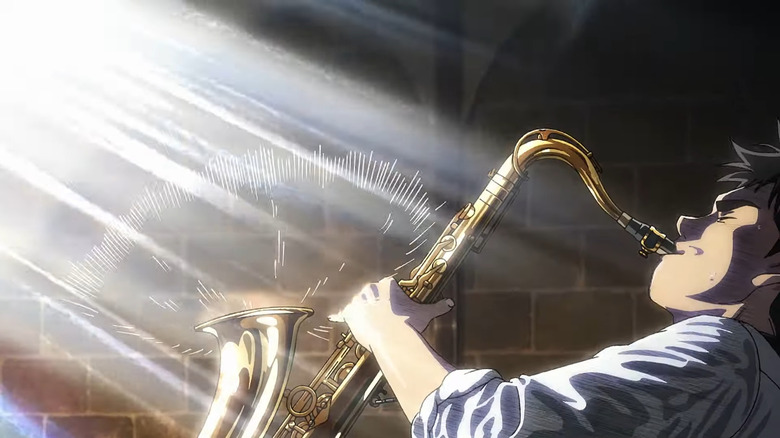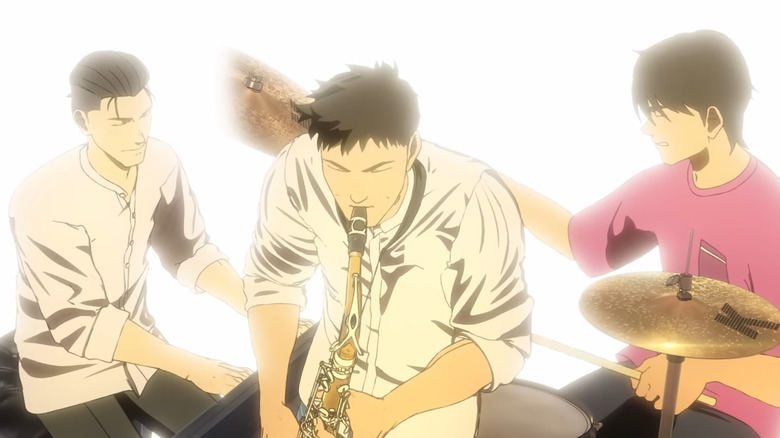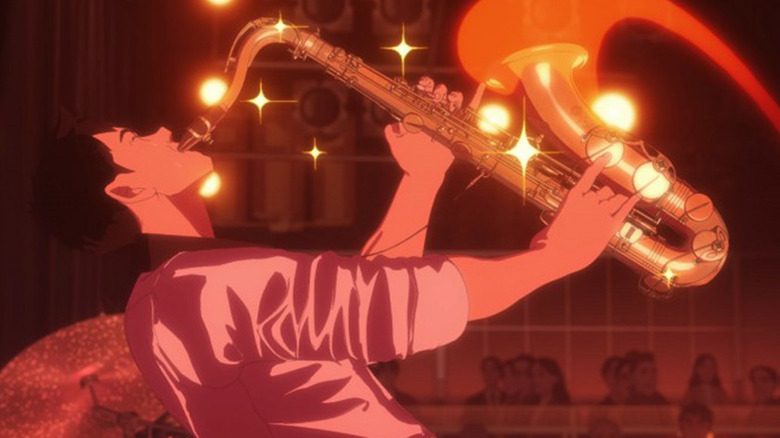One Anime Does Everything La La Land Tried, And Failed, To Do
This year has seen many spectacular animated movies. From "Spider-Man: Across the Spider-Verse" to "The First Slam Dunk," we've seen movies that make full use of their medium and deliver stunning visuals that push the artform forward. The latest to join that list is "Blue Giant," the highly anticipated adaptation of the Shinichi Ishizuka manga of the same name, directed by Yuzuru Tachikawa ("Death Parade," "Mob Psycho 100") and written by Number 8.
The film follows a trio of young Japanese men looking to leave their mark on the jazz scene. Dai Miyamoto plays the saxophone and leads the group with his burning passion for music. Along for the ride is Yukinori Sawabe, who doesn't share Dai's optimism for becoming a star, having played piano since he was 4 years old without much to show for it. And lastly, there's Dai's roommate Shunji Tamada, who is inspired by Dai's love of jazz and decides to pick up the drums ... despite being terrible at it. Yet, what Tamada lacks in natural talent, he compensates with hard work.
The trio have vastly different takes on how and why to play. Should it be for the sake of having fun with friends? For the love of the art? To be technically perfect? What follows is not only a fun music anime story, but also one of the best movies about the sheer power of jazz — one that succeeds where "La La Land" failed at showing why jazz is dying and how people are keeping it alive.
A dying art
You remember "La La Land," right? The Best Picture Oscar almost-winner by Damien Chazelle about an aspiring jazz musician and an aspiring actor falling in love, then realizing that for some reason they couldn't be together or their dreams would die. Remember the silly scene where Ryan Gosling explains jazz? Every movie about jazz or that even just touches on jazz has something like it, where it talks about jazz as a dying genre and why it is so cool.
When it comes to "Blue Giant," that argument comes early, when we first meet Sawabe playing a gig for another band. He complains to Dai that the rest of the band is no good because they stick to old techniques and sounds rather than innovate. Not many listen to jazz, and if they play the same old thing it will die off, he argues. But what matters is not the argument. It is not Sawabe saying that jazz is dying, but showing how vibrant the jazz scene is in Japan and then showing audience halls half empty — unless it's the famous, big-ticket clubs.
"Blue Giant" doesn't just talk the talk. It also shows that the popularity of jazz has waned in modern-day Japan, yet it still has one of the biggest jazz scenes in the world (the genre broke into the country's mainstream in the '20s and never really let go). This demonstrates that jazz is slowly waning better than just having a single dude explain that jazz is dying.
A beautiful art
The movie also shows the power of jazz to move people with music in a way only animation can do, combining 2D, CG, and even rotoscope techniques.
Studio NUT delivers some of the most dazzling visuals in an animated movie this year. Every time Dai and his pals onto the stage, the film uses abstract imagery — the kind Tachikawa would constantly employ in "Mob Psycho 100" — to showcase the emotional layer of jazz music. The more they practice, and the more harmonic they become as a group, the more ecstatic their performances become. Bodies morph and melt into abstract shapes. Dai's saxophone literally blows the audience away. The trio transports and plays inside a supernova. Plus, there is so much sweat hitting their instruments and the floor that you could fill a bath with it.
But it is not just showing audiences the power of jazz through incredible visuals that "Blue Giant" does better than "La La Land." It also does the third act split better, showing the cost of following your dreams, and how not everyone is on the same path.
"La La Land" ends with Mia and Sebastian saying goodbye for some reason, realizing suddenly that they could either be together or follow their dreams. Here, we get a more nuanced take on the same idea. And that idea is shown from the very beginning. The three friends know they are not on the same skill level. They know Dai will continue rising higher and higher, and they won't be able to keep up. The group will only really have this moment together, so they might as well have fun while it lasts.


